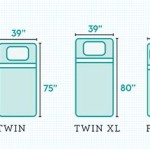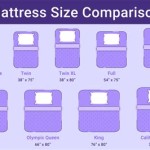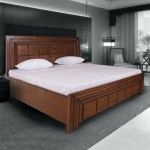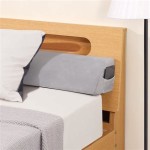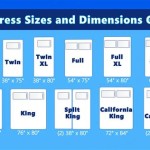Bed Frame Measurements By Size: A Comprehensive Guide
Selecting the appropriate bed frame is crucial for ensuring both comfort and optimal sleep. The bed frame not only provides structural support for the mattress, but also contributes significantly to the overall aesthetics of the bedroom. Understanding bed frame measurements by size is essential for making informed decisions and avoiding potential compatibility issues between the frame and the mattress. Furthermore, considering the available space within the bedroom is paramount to ensure the bed frame fits comfortably and allows for adequate movement.
This article provides a comprehensive guide to bed frame measurements by size, covering standard dimensions, variations, and essential considerations for selecting the right frame for individual needs and spatial constraints. Accurate measurements are particularly important when purchasing online, where physical verification is not possible prior to purchase. This guide aims to equip individuals with the knowledge necessary to navigate the complexities of bed frame sizing and make a well-informed purchase that promotes a comfortable and functional bedroom environment.
Standard Bed Frame Sizes and Dimensions
The bed frame industry adheres to certain standard sizes, although minor variations may exist between manufacturers. These standard sizes generally correlate with mattress sizes, ensuring compatibility between the two. Understanding these standard dimensions is the first step in selecting the appropriate bed frame.
Twin Bed Frame: A twin bed frame, also known as a single bed frame, is the smallest standard size, typically measuring approximately 39 inches in width and 75 inches in length. This size is ideal for children's rooms, guest rooms, or smaller bedrooms where space is limited. Twin bed frames are also a common choice for bunk beds and daybeds. The compact dimensions make them versatile for various room layouts.
Twin XL Bed Frame: The Twin XL bed frame shares the same width as a standard twin but offers an extended length, measuring approximately 39 inches in width and 80 inches in length. The extra length caters to taller individuals, providing additional legroom and enhanced comfort. Twin XL bed frames are commonly found in college dormitories due to their space-saving width and accommodating length.
Full Bed Frame: Also known as a double bed frame, a full bed frame measures approximately 54 inches in width and 75 inches in length. While wider than a twin, a full bed frame may feel cramped for couples. It is generally considered suitable for single adults who desire more sleeping space than a twin offers, or for smaller guest rooms where a larger bed frame would be impractical.
Queen Bed Frame: The queen bed frame is a popular choice for both single sleepers and couples, offering a balance between space and affordability. It measures approximately 60 inches in width and 80 inches in length, providing ample room for comfortable sleep without overwhelming the bedroom. Queen bed frames are versatile and suitable for master bedrooms, guest rooms, and apartments.
King Bed Frame: A king bed frame provides significant sleeping space, measuring approximately 76 inches in width and 80 inches in length. It is an excellent choice for couples who prefer ample personal space or for individuals who move frequently during sleep. King bed frames are best suited for larger master bedrooms, ensuring sufficient space for movement and other furniture.
California King Bed Frame: The California King bed frame is longer and slightly narrower than a standard king, measuring approximately 72 inches in width and 84 inches in length. This size is particularly well-suited for taller individuals, offering extended legroom. California King bed frames are less common than standard king sizes, but are a viable option for those who prioritize length over width.
It is important to note that these measurements refer to the interior dimensions of the bed frame, designed to accommodate the corresponding mattress size. The exterior dimensions of the bed frame may vary depending on the style and design, particularly if the frame includes a headboard, footboard, or side rails. Therefore, it is crucial to consider the overall footprint of the bed frame when evaluating its suitability for a particular space.
Factors Influencing Bed Frame Dimensions
While standard sizes provide a general guideline, several factors can influence the actual dimensions of a bed frame. These factors relate to the design, style, and specific features of the frame, and should be taken into account when determining the overall space requirements.
Headboard and Footboard: The presence of a headboard and/or footboard can significantly impact the overall length of the bed frame. Headboards can range from simple, minimalist designs to elaborate, oversized structures. Similarly, footboards can add length and visual weight to the frame. The dimensions of the headboard and footboard must be considered when calculating the total space occupied by the bed frame.
Side Rails: Side rails are essential components of a bed frame, providing structural support and connecting the headboard and footboard. The width and thickness of the side rails can vary depending on the design and materials used. Thicker side rails will naturally increase the overall width of the bed frame, while decorative features on the side rails can further extend the dimensions.
Platform vs. Traditional Frames: Platform bed frames typically have a lower profile than traditional frames and may not require a box spring. This can affect the overall height of the bed and the amount of visible space around the frame. Traditional frames, on the other hand, often incorporate a box spring, which adds to the overall height and can influence the perceived size of the bed. The style of the frame contributes significantly to its visual impact within the room.
Storage Features: Some bed frames incorporate storage features, such as drawers or shelves built into the base. These integrated storage solutions can increase the overall dimensions of the frame, particularly in terms of width and depth. When considering a bed frame with storage, it is essential to ensure that the drawers or shelves can be easily accessed without obstruction from other furniture or walls.
Style and Design: The overall style and design of the bed frame can also influence its dimensions. For example, a sleigh bed frame, with its curved headboard and footboard, will typically have a larger footprint than a simple, rectangular frame. Similarly, ornate or decorative frames may have protruding elements that extend beyond the standard dimensions. Therefore, it is crucial to carefully examine the specific design of the bed frame and account for any variations from the standard measurements.
When selecting a bed frame, it is advisable to consult the manufacturer's specifications for accurate dimensions. These specifications should include the overall length, width, and height of the frame, as well as the dimensions of any additional features, such as the headboard, footboard, or storage compartments. This information will ensure that the bed frame fits comfortably within the intended space and meets individual needs.
Measuring Your Space for a Bed Frame
Accurately measuring the available space within the bedroom is crucial for ensuring that the selected bed frame will fit comfortably and allow for adequate movement. Failure to measure the space accurately can result in a bed frame that is too large, obstructing walkways and hindering functionality. The following steps outline the process of measuring the space and determining the appropriate bed frame size.
Measure the Room Dimensions: Begin by measuring the length and width of the room using a measuring tape. Record these measurements accurately, as they will serve as the foundation for determining the maximum allowable size of the bed frame. It is also important to measure the height of the ceiling, particularly if considering a bed frame with a tall headboard.
Consider Existing Furniture: Take into account the placement and dimensions of existing furniture, such as dressers, nightstands, and wardrobes. Ensure that there is sufficient space to open drawers, access closets, and move around the bed without bumping into other furniture. A minimum of two feet of walking space around the bed is generally recommended.
Factor in Doorways and Windows: Account for the location of doorways and windows, as these can impact the placement and orientation of the bed frame. Avoid blocking doorways or windows with the bed frame, as this can impede access and airflow. Consider the swing of the door when determining the ideal placement of the bed frame.
Visualize the Bed Frame: Use masking tape or cardboard to create a visual representation of the bed frame's dimensions on the floor. This will help to visualize how the bed frame will fit within the space and identify any potential obstacles. It is also helpful to consider the placement of electrical outlets and light switches, ensuring that they remain accessible after the bed frame is installed.
Account for Headboard and Footboard: Remember to account for the dimensions of the headboard and footboard when calculating the overall space required for the bed frame. These features can significantly increase the length and width of the frame, and should be factored into the measurements. If the bed frame has a particularly large or elaborate headboard or footboard, it may be necessary to adjust the placement of other furniture to accommodate the additional space requirements.
Allow for Movement and Circulation: Ensure that there is adequate space for movement and circulation around the bed frame. A minimum of two feet of walking space is generally recommended, but this may vary depending on the size of the room and the individual's needs. Consider the placement of bedside tables and ensure that there is sufficient space to reach them comfortably from the bed.
By carefully measuring the available space and considering the dimensions of the bed frame, it is possible to select a frame that fits comfortably within the room and promotes a functional and aesthetically pleasing bedroom environment. Accurate measurements are essential for avoiding potential compatibility issues and ensuring that the bed frame meets individual needs and preferences.

2024 Bed Frame Sizes Mattress Dimensions Australia B2c Furniture

2024 Bed Frame Sizes Mattress Dimensions Australia B2c Furniture
What Is The Width Of A Queen Size Bed Frame Quora

Cuenca Bed Frame Japan Size Bedandbasics

2024 Bed Frame Sizes Mattress Dimensions Australia B2c Furniture

Top 40 Useful Standard Bed Dimensions With Details Engineering Discoveries Single Wooden Frames

Tretan Bed Frame Furniture Home Décor Fortytwo

Verena Bed Frame Metal Frames Beds Bedroom Furniture Sets Home Décor Fortytwo

2024 Bed Frame Sizes Mattress Dimensions Australia B2c Furniture
Line Storage Bed Dimensions Drawings Com


